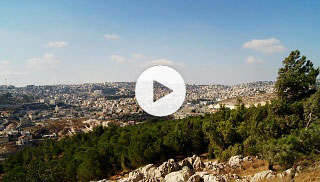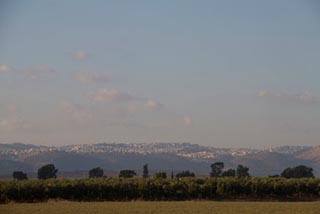13:1–9 Matthew 13 consists of eight parables. The first—the parable of the sower—describes four different responses to the message of the kingdom of heaven that Jesus and His disciples preach. Jesus interprets the parable in vv. 18–23. |
 Parables of Jesus Table
Parables of Jesus Table
Parable of the Sower | ||
13:1 On that day This phrase links ch. 13 with the preceding chapter.
by the sea The Sea of Galilee.
13:2 got into a boat Jesus may have gone out on the water a short distance to improve people’s ability to hear Him, as sound travels better over the water. If He remains surrounded by the crowd, His words may not be heard.
13:3 parables In His parables, Jesus compares the kingdom of heaven, or certain aspects of it, to common situations of His day (such as farming and fishing).
Jesus compares the kingdom of heaven, or certain aspects of it, to common situations of His day (such as farming and fishing).
13:5 rocky ground Not loose stones in the soil, but ground with a shelf of bedrock close to the surface. The soil above the bedrock warms quickly, so seeds readily sprout, but the shallow soil cannot sustain growth.
13:8 this one a hundred times as much An extraordinary harvest. A tenfold harvest would have been considered a good crop. Jesus explains these three figures in v. 23. The phrase used to describe the harvest means “100 times (or 60, or 30) as had been planted.”
13:10–17 The disciples ask Jesus why He speaks in parables. He responds by quoting the ot and drawing a comparison between His ministry and Isaiah’s. |
13:11 To you it has been granted Verses 11–12 contains the positive response to their question and commends the disciples’ faith, while v. 13 condemns the unbelief of some of His hearers. God gave them the capacity to understand.
13:12 whoever has Refers to those who have been given understanding regarding the kingdom of heaven and Jesus’ message. See v. 11 and note.
what he has will be taken away Those who do not have understanding about the kingdom of heaven have nothing of value because the kingdom of heaven is the only thing of lasting value (compare vv. 45–46; 25:29).
13:13 I speak to them in parables Rabbis used parables for illustrative purposes and typically provided an explanation. Jesus, however, did not always offer an interpretation. His followers likely viewed some of His parables as riddles rather than illustrations. Jesus indicates that this was an intentional feature of His teaching ministry.
for illustrative purposes and typically provided an explanation. Jesus, however, did not always offer an interpretation. His followers likely viewed some of His parables as riddles rather than illustrations. Jesus indicates that this was an intentional feature of His teaching ministry.
seeing they do not see An allusion to Isa 6:9. Just as Israel rejected Isaiah’s message then, so Israel rejects Jesus’ message now.
13:14 with reference to them Just as the Jews in Isaiah’s day rejected the message of God, they now reject the kingdom of God as offered by Jesus.
prophecy of Isaiah Introduces Jesus’ quotation of Isa 6:9–10 as it appears in the Septuagint (the Greek translation of the ot).
 Jesus’ Fulfillment of Old Testament Prophecy Table
Jesus’ Fulfillment of Old Testament Prophecy Table
13:17 truly I say to you See Matt 8:10 and note.
13:18–23 In a rare display, Jesus explains one of His parables |
13:19 word about the kingdom Represented by the seeds in Jesus’ initial telling of the parable. The seed is always good; the variance is in where the seed lands.
the evil one comes Satan and his minions (see note on 6:13), whom Jesus represents as birds in v. 4.
13:20 immediately receives it with joy Describes people who receive Christ’s kingdom teaching but abandon their initial excitement due to life’s difficulties.
13:22 the anxiety of this world Similar to the seed sown on rocky ground, the cares of the world lure this person away.
13:23 who indeed bears fruit This person eagerly receives Christ’s kingdom teaching and acts in accordance with it (see v. 8 and note).
13:24–30 Jesus returns to addressing the crowd (as opposed to His disciples in the boat) and offers them a second parable. Jesus later offers His disciples an explanation (vv. 36–43). |
13:24 the kingdom of heaven Many of Jesus’ parables describe the kingdom of heaven. He uses experiences common to the people of His day to help them understand the coming and growth of the kingdom (vv. 11, 33, 44, 45, 47; 20:1; 18:23; 22:1; 25:1). Jesus explains the parable later in the chapter (vv. 36–43).
13:25 darnel The Greek word used here refers to a kind of weed that resembles wheat until both reach maturity.
13:31–33 The next two parables in ch. 13 stress the inevitable growth of the kingdom of heaven, despite the resistance it faces. The parable of the mustard seed contrasts the seemingly insignificant inception of the kingdom of heaven, in the world and in a person’s life, with its momentous results. |
Parable of the Mustard Seed | ||
13:31 mustard seed A tiny seed that grows into a 10-foot-high shrub. The shrub grew along the shores of the Sea of Galilee and may have been immediately in view of Jesus’ hearers.
13:32 the smallest of all the seeds Refers to seeds planted by farmers in Galilee. Rabbis used the mustard seed as a proverbial object to denote the smallest possible amount or size of something. Compare Matt 17:20.
13:33 yeast A substance that causes dough to ferment and rise. Normally, yeast or leaven has negative connotations in the Bible, symbolizing sin or impurity (e.g., 16:6; 1 Cor 5:6–7). Here, Jesus uses it positively to symbolize the kingdom of heaven’s expansion.
three measures Approximately 50 pounds—enough to feed about 150 people. Basically invisible when combined with flour, the leaven would become apparent as the dough baked and expanded into a great quantity.
13:34–35 Similar to Matt 13:10–17, this section reiterates Jesus’ purpose in using parables. |
13:35 would be fulfilled See note on 1:22.
the prophet The quotation in this verse is from Psa 78:2. This psalm identifies its author as Asaph, who is described in 2 Chronicles as a seer (see note on Psa 73:title; note on Psa 78:2; 2 Chr 29:30).
 Jesus’ Fulfillment of Old Testament Prophecy Table
Jesus’ Fulfillment of Old Testament Prophecy Table
13:36–43 Jesus privately interprets the parable of the weeds (Matt 13:24–30) for His disciples. |
13:36 Then he left the crowds Jesus presumably leaves the boat (see v. 2) and returns to the house (possibly Peter’s house, see 8:14; 9:10).
13:37 the Son of Man See note on 8:20.
13:39 the harvest is the end of the age Refers to the eschatological ingathering of the people of God to life, and His opponents to death. Rev 14:14–20 likely draws from this tradition (see Matt 14:15 and note). Compare v. 30.
13:42 fiery furnace Fire is a common symbol for divine judgment. See note on Luke 3:9. This also might allude to the story of Shadrach, Meshach, and Abednego in Dan 3. The servants of Nebuchadnezzar who came near the fiery furnace were destroyed (Dan 3:22), while God’s faithful people lived (Dan 3:27).
weeping and gnashing of teeth This refers to the day of final judgment (Rev 20:11–15). Once God’s judgment comes, it will be unbearable for those who have not chosen to follow Jesus. See note on Matt 8:12.
13:43 the righteous will shine like the sun An allusion to Dan 12:3.
13:44–46 These two parables describe the great value of the kingdom of heaven, as well as the extreme and urgent measures people should take because of it. |
13:46 he went and sold everything The point is not that the man purchased a place in the kingdom of heaven, but rather that entering the kingdom is worth giving up everything.
13:47–52 Similar to the parable of the weeds (Matt 13:24–30), this parable describes the ingathering of the righteous and wicked and their subsequent fates. The kingdom of heaven will consist of those who follow Jesus. |
13:47 a dragnet A net with floats on one end and weights on the other. Fishermen cast the net into the sea and allowed the weighted end to sink to a sufficient depth. When they pulled it in, the net scooped up everything in its path.
13:48 but the bad they threw out The fishermen sorted the fish like the reapers sorted the wheat and the weeds (v. 30).
13:50 weeping and gnashing of teeth See note on v. 42.
13:52 For this reason In answering affirmatively, they become responsible for making the truth known to others.
new things and old things The disciples were beginning to understand the new things Jesus was teaching in conjunction with the traditions from the Scriptures they already knew.
13:53–58 Following His teaching in parables, Jesus travels to His hometown. Because of their familiarity with Jesus, the people of Nazareth reject Him as a prophet. |
13:54 his hometown Jesus’ base of ministry was Capernaum, but He had grown up in Nazareth
but He had grown up in Nazareth (2:23).
(2:23).
where did this man get this wisdom The people know that, unlike their rabbis, Jesus has no formal training; He was raised as a craftsman. They express astonishment at the apparently educated things He says and the attesting signs He performs.
13:56 where then did this man get all these Despite recognizing that Jesus did not acquire these skills from His family, the people cannot understand the nature of His prophetic and messianic callings.
13:57 And they were offended by him Their offense comes from Jesus’ claim to be something that they assume He is not.
A prophet is not without honor except Jesus receives honor wherever He goes, except when He comes home. The people of His hometown—and even some members of His own family—reject His message and claims.
and in his own household Refers to His family. Jesus’ brothers rejected His messianic claims until after His resurrection (see Acts 1:14).
13:58 because of their unbelief Jesus does not need to prove His authenticity with signs; the people have already rejected His message.

|
About Faithlife Study BibleFaithlife Study Bible (FSB) is your guide to the ancient world of the Old and New Testaments, with study notes and articles that draw from a wide range of academic research. FSB helps you learn how to think about interpretation methods and issues so that you can gain a deeper understanding of the text. |
| Copyright |
Copyright 2012 Logos Bible Software. |
| Support Info | fsb |
 Loading…
Loading…






